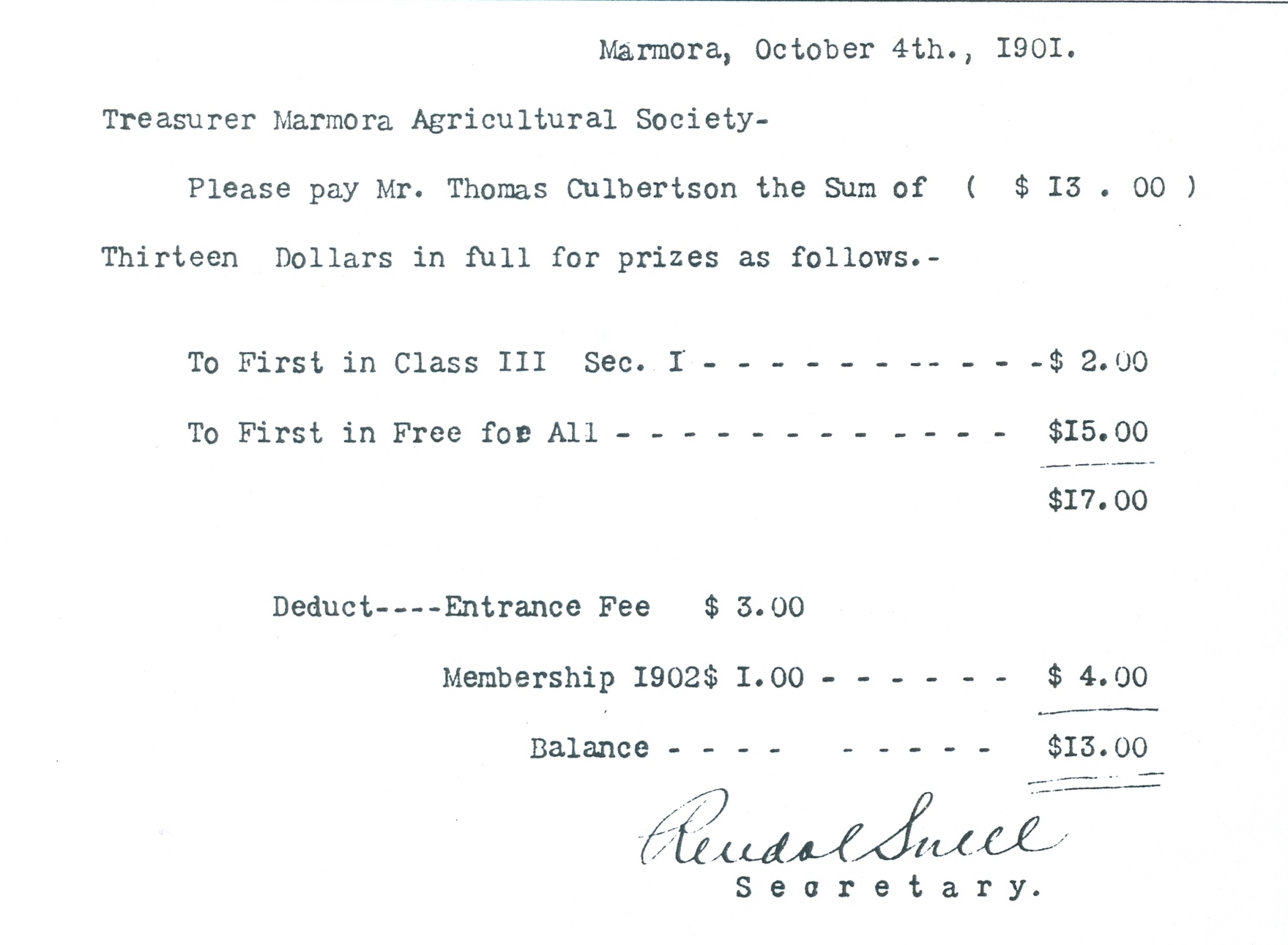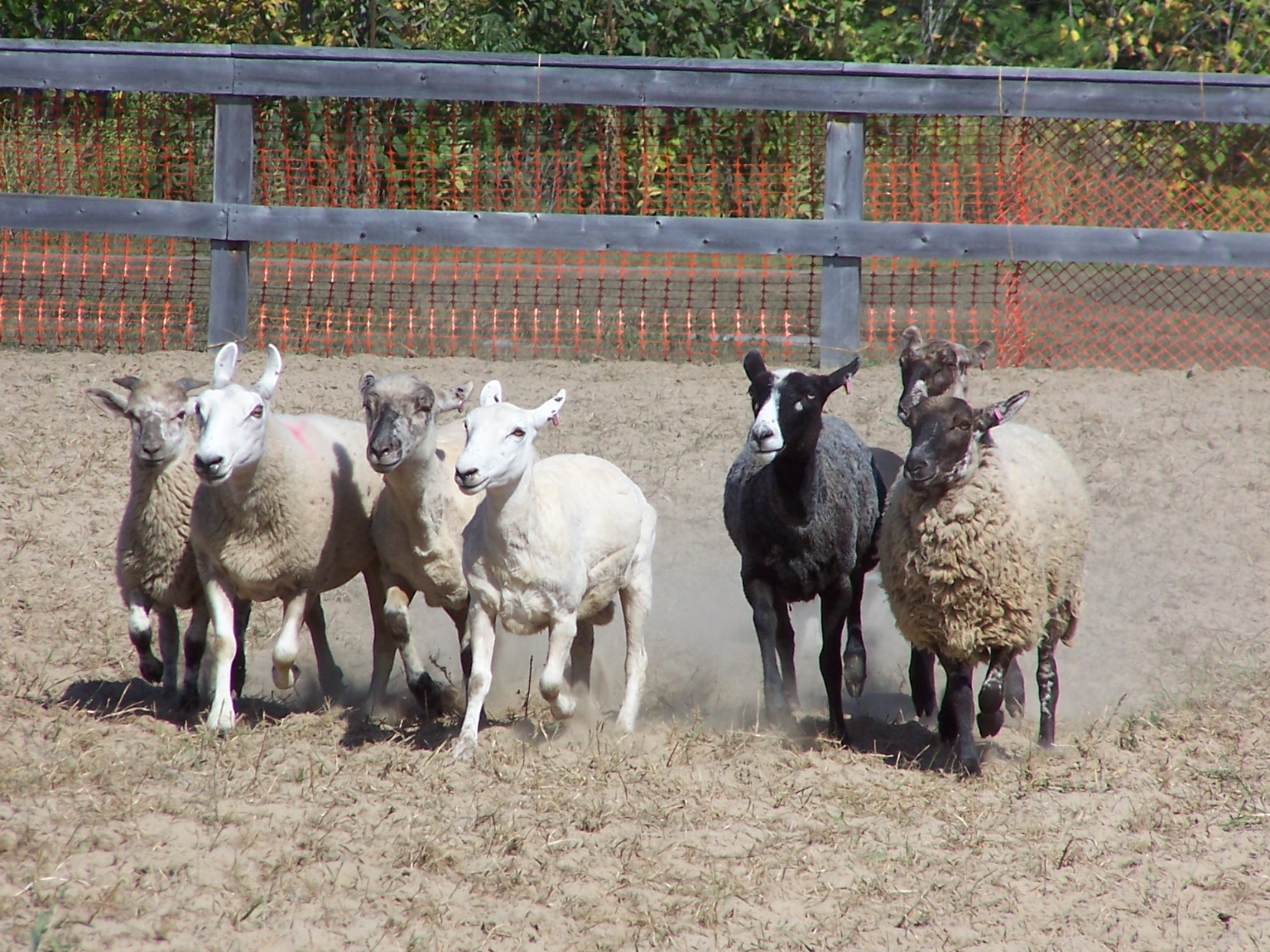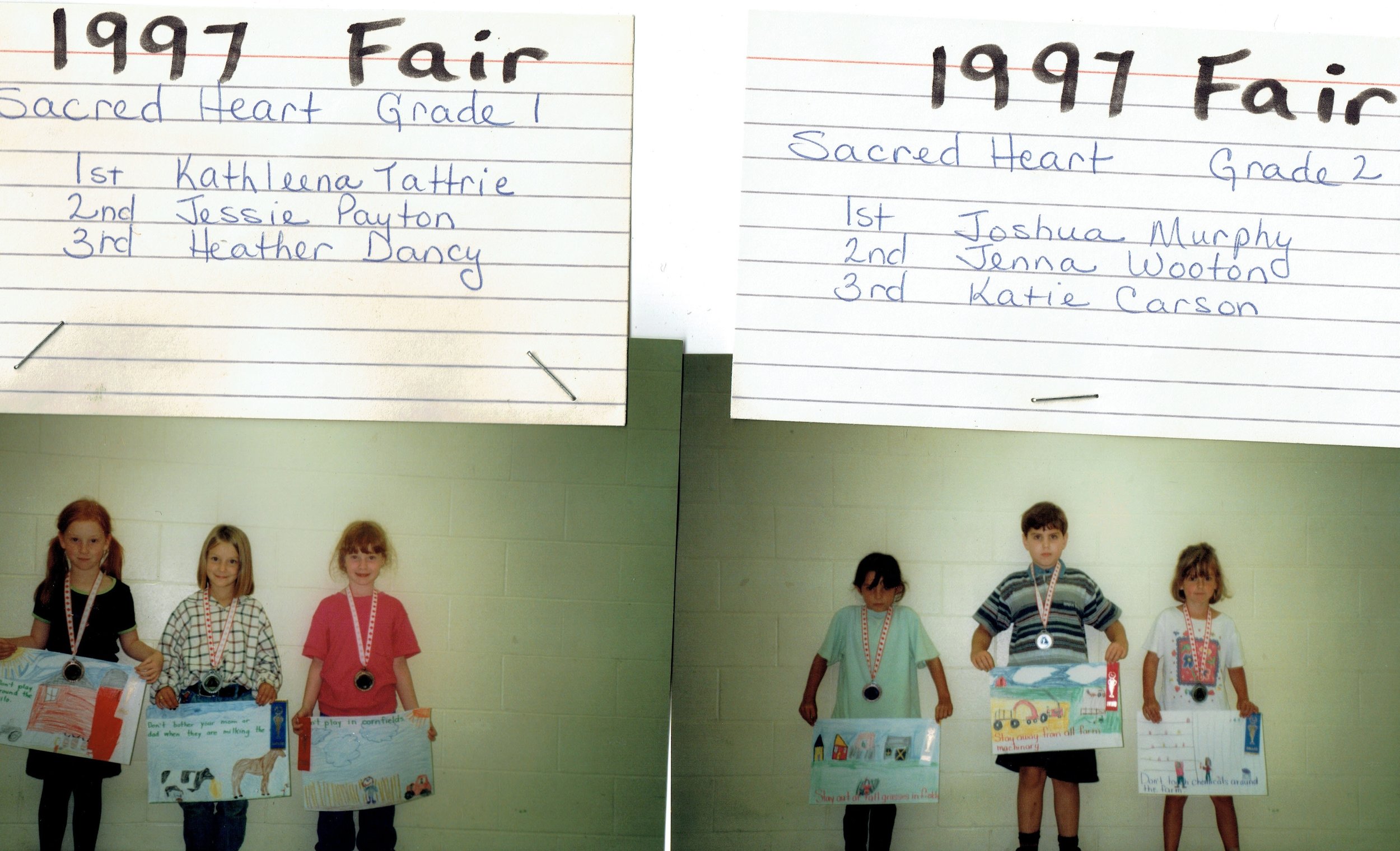THE MARMORA AGRICULTURAL SOCIETY AND THE MARMORA FAIR
Most likely aphoto by Tom Stewart, Marmora photographer
Harry (Jake)Neal .... "I started going to the fair when I was about nine years old, which would have been in about 1922. Then there were horse shows and some people showed their horses and buggies. Everyone pretty well came to the fair by horse and buggy in those days, and they would take the harness off the horses and tie them to posts where the horse barns are now. There were some ball games and.running races for girls and boys. The old tatty man, Gilly Ellis,was there in those days and there were snacks and cold drinks, the same as today, except they were called by different names. When we showed cows at the fair we had to herd them down the highway (Highway #14) to the fair, which would be just over one mile. We tried to keep the cows off to the side of the road as much as we could. I started taking tickets at the gate when I was about 20 years old,and stopped when I was in my 60's. When I first started, it would have cost maybe fifty cents to get into the fair."
1926 Marmora Fair Postponed
1931 Fair featured the Hon Robert Weir, MP a former Marmora Public School teacher
Robert Weir M.P., Minister of Agriculture and former Marmora Public School teacher, attends Marmora fair 1934
THE ORIGIN OF THE 1909 POSTER
As evidenced by Olive Deacon's Home & School magazine, this picture originally acted as an inspiration for creative writing. "Where do the boys go and what happens to them?"
1972
The Marmora Fair board writes:
In 1890, the people of Marmora joined together to form the Marmora Agricultural Society, an organization developed for the purpose of having members of the community come together to visit, share good times and "show off" livestock, produce and talents. Early fairs, which were only one-day celebrations, were held in the fall and the date varied - either September or October. Public school children went to school in the morning, then marched over to the fair.
Jim Shannon .... "The first I remember about the fair is when I was going to school at the White Hall, on the corner of Madoc and Hayes Streets. I was in junior first, which would be like grade one is today, (around 1912) and in those days you marched to the fair like little soldiers whether you wanted to or not. The advantage was that you got in for nothing. I remember the red building, just like a barn, that stood where the rink would be today and all the displays were in there. And the midway was always a big event, but there was a constant battle between the city slickers that came to work the midways, and us. They came and tried to take people for a ride, and lots of times they did: There were kewpie dolls as prizes and the shell game, where you tried to guess what shell a dollar was under. There was also the game where you tried to hit the bell, up at the top of a pole, as hard as you could by hitting a hammer onto the bottom of the platform.·
Ralph Neal ....I can remember many interesting things that took place on the fairgrounds. When I came to Marmora in 1914, Marmora had a real good lacrosse team and their playing field was on the grounds at the east end of where the midway ends. When the public school burned in May of 1916,the Red Exhibition Building was used for school. until the restoration of the public school was completed in the early fall. This building was later tom down to make way for the new arena.
Marmora decided to enter an inter-mediate baseball team in the newly formed Trent Valley Baseball League with Deloro, Havelock, Tweed and Marmora, and it was decided that the fair grounds were the only place. There were some very tall pine trees that had to be removed, one back of third base and one or two back of first base. so the trees were cut but the stumps had to be taken out. At this period of time one of the local merchants was selling dynamite and it was decided that the dynamite company would use the stumps for demonstration purposes. They were all loaded and shot at the same time. The stump back of third base landed somewhere over in O'Con- nor's woods and the other two landed in the back yard of the houses north of the fair grounds.
In my early years at the fair, the race track was almost round and the horses had to make three revolutions for a mile. It was during that time that my father was president of the fair and it was decided to enlarge the track by a half mile. Incidentally, the present track is just a few feet short of being a half mile and this was done purposely, so that a racehorse couldn't be given a set time mark.
I recall that the Marmora Agricultural Society belonged to the Ontario Rural Fairs Association and they set the date of local fairs. In 1916 my father went to the meeting in Toronto and, through a lot of pull, he got the Marmora fair date set for September 16, since we were running the Royal Hotel at the time and this would be the last day that we could legally sell alcoholic beverages, as it was the day that Prohibition became law for the province of Ontario. I can assure you that we had one of the largest attendances that day."
The Unfortunate death of Mrs. M. Fitzpatrick1921
Click here to read details of the inquest
Bill Doyle remembers "My dad was about 21 years old in 1907 when they used to race the horses and buggies. That particular year he had his horse tied to a pine tree near the track before the race and had a brand new buggy to race with. Nearly at the end of the race the horse decided to go to where he had been tied up before and ran the front part of the buggy up the tree. I remember dad telling us that it was the end of that buggy but it was nearly the end of him, too.
In 1913,which is the earliest prize list available to us,there were 76 adults and 8 children exhibiting at the fair. The adults exhibited such things as a carriage team,. a 2 year old colt, Brahma hen, Peking duck and a Shropshire ram. Also shown were sheaves of corn and snow apples. Ladies exhibited butter in roll, hemstitching, gooseberries, orange marmalade, embroidery monogram or initial darning, celery, mangles and coronation braiding. Children exhibited writing and map drawing.
The fair progressed through the years. Board members held euchre parties and street dances during the summer to raise funds to help pay for prize monies and for upkeep of the fair grounds. In1936,a new Ford car was raffled. Dan Bell of Bonarlaw was the very lucky winner.
The fair continued into World War II years and in 1943 the Honourable George Drew, Premier of Ontario, was invited to give the "address" at the fair. Entertainment was by Jock Thynne, the Kansas Farmer. Later,because of decreasing manpower, it was decided to discontinue the fairs until after the war. It was also decided exhibitors, from whom prize money was retained, would be counted as members the first year the fair would be held again.
The Agricultural Society itself stayed active. They held small euchre parties and in1944 and 1945; they advertised and held their annual meeting. Finally,April 9, 1946, at a meeting in the council chamber with 30 members present and T.J.Bateman acting as chairman, it was unanimously decided the time was right to hold the fair again. The dates were set for September 26 and 27, 1946.
In 1948,the community wished to build an arena and the Agricultural Society agreed a new building was needed. So the Society sold the land to the Village of Marmora, then shared the expense of building the arena. In 1951,the directors decided it would benefit the fair a great deal if the date were the same every year. They chose Labour Day: the last big weekend of the summer.
During the 50'sand 60's, the Agricultural Society always held a street dance in Marmora in summer. Then, in 1968, the Society, with the co-operation of the Cross Country Jamboree, began sponsoring an Old Tyme Fiddle and Stepdancing contest on the first long weekend of the summer in July. This proved a very successful venture and continued for 10years.
1953
Lacrosse, hardball and softball were popular and there was a bandstand on the fair grounds inthe 1920's.Then, the fair grounds were the hub of the community and all church picnics, parades and field days were held there. There used to be a 'Hitch and Go' race where the horses would be unharnessed and then faced towards the buggy. The first horse to be completely harnessed and through the finish line won. There was also a 'slow race' where racers used other racers' horses. The reins were shortened so you could hardly reach them and no whips could be used. Then, the last horse to cross the finish line won, so the fun was trying to see if you could get the other guy's horse to run while you were racing it.·"
Left - Cecil Bell
1950's
In 1954, the wrestling of 550 pound bears, and performance of trained animals in a side show attracted a good percentage of fair attendants. It would have been a similar spectacle as the picture below which is dated 1910.
In 1979 a Bluegrass Festival was held. In 1983, the Agricultural Society began sponsoring a Country & Western show in July. This brought many famous artists to Marmora and was continued until 1987.
The people of the area have supported the fair in Marmora well, so to show their appreciation the Agricultural Society established 'The Marmora Agricultural Society Award" in 1988. This is a bursary presented to a deserving Marmora student who is continuing in a post-secondary education.
(Intro in 100th anniversary booklet)
Stan Tink Kerr
c. 1968
Date unknown
Sept/ 13, 1972
The 80's
1990 - The 100th anniversary
Articles from 2003
Click here for more random articles on the Fair
2005
SpecialHand Carved Lumbering Display by Delbert & Leslie Irish of Millbridge
4 H CLUBS OF CANADA
It was in 1913 that the Department of Agriculture through the Extension Department of the University of Manitoba organized eight Boys & Girls Clubs in Manitoba. The first one, being in Roland, The Department gave each new member one dozen eggs from a good breed of laying hens, good quality seed of fodder corn and seed potatoes. The eggs were set in the spring under a hen and the corn and potatoes were planted painstakingly in the corner of a field or garden and tended by the members. In the fall the communities held a fair where the chickens and the produce were judged. In 1952 the name was changed from Boys and Girls Clubs to 4-H in keeping with the name of the 4-H Clubs in the United States.
4H Pledge
My Head to clearer thinking.
My Heart to greater loyalty.
My Hands to larger service.
My Health to better living.
For my club, my community and my country.
4-H Motto "Learn to do by doing"













































































